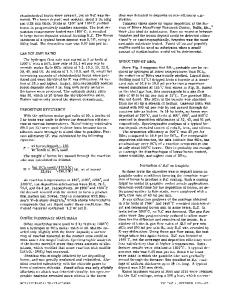Design and Syntheses of Poly(Norbornenyldecaborane) Precursors to Boron Carbide and Boron-Carbide/Silicon-Carbide Cerami
- PDF / 149,377 Bytes
- 6 Pages / 612 x 792 pts (letter) Page_size
- 30 Downloads / 366 Views
FF1.8.1
Design and Syntheses of Poly(Norbornenyldecaborane) Precursors to Boron Carbide and Boron-Carbide/Silicon-Carbide Ceramics Xiaolan Wei,1 Daniel T. Welna,2 Jared D. Bender,2 Larry G. Sneddon,1 Harry R. Allcock2 1 2
Department of Chemistry, University of Pennsylvania, Philadelphia, PA 19104 Department of Chemistry, The Pennsylvania State University, University Park, PA 16802
ABSTRACT Poly(norbornenyldecaborane) (PND) was synthesized via ruthenium catalyzed ring opening metathesis polymerization and was found to be a good single-source polymeric boron carbide precursor. Polymer blends of PND and allylhydridopolycarbosilane (AHPCS) were also found to be excellent precursors to boron-carbide/silicon-carbide composite materials. INTRODUCTION Boron carbide is an important non-oxide ceramic material that is of great interest because of its chemical inertness, low density, high thermal stability, hardness, high cross-section for neutron capture, and excellent high-temperature thermoelectric properties [1-3]. These properties give rise to numerous applications, including uses as an abrasive wear-resistant material, ceramic armor, a neutron moderator in nuclear reactors and, potentially, for power generation in deep space flight applications [4,5]. While boron carbide powders can be readily made by the direct reaction of the elements at high temperatures, new synthetic methods that allow the formation of boron carbide in processed forms still need to be developed. We report here the synthesis of a new processable organodecaborane polymeric precursor that has enabled [6, 7] the formation of nanofibers of boron carbide and related ceramic composites. EXPERIMENTAL DETAILS The monomers 1, 2 and the polymers 3, 4 were synthesized and characterized as described in the literature [8]. Polymer pyrolyses were performed in a Lindberg Model 54434 1700°C tube furnace under high purity argon. The elemental analyses were performed at the Laboratory for Organic Microanalysis, Nesmeyanov Institute of Organoelement Compounds in Russia. Diffuse reflectance infrared Fourier transform (DRIFT) spectra were obtained with a Mattson Galaxy FT-IR spectrometer. Thermogravimetric analysis (TGA) traces were obtained on a Texas Instruments SDT 2960 Simultaneous DTA-TGA with a ramping rate of 10°C/min to 1200°C and an argon gas purge rate of 80 mL/min. X-ray diffraction (XRD) patterns were obtained with a Rigaku Geigerflex automated X-ray powder diffractometer using Cu Kα radiation and a graphite monochrometer. Scanning electron microscopy (SEM) images were obtained with a JOEL 6300 high resolution scanning electron microscope. The samples were coated with gold and platinum. DISCUSSION As a result of our interest in the design of new polymeric precursors to boron carbide and related materials, we have been investigating the development of new general metal-catalyzed
FF1.8.2
methods for the synthesis of polyborane polymers. We have previously shown [9] that the Cp2ZrMe2/B(C6F5)3 system [10] efficiently polymerizes 6-hexenyldecaborane to polyhe
Data Loading...






